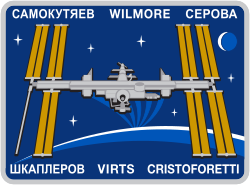Barry E. Wilmore
| Barry Eugene Wilmore | |
 | |
| NASA Astronaut | |
|---|---|
| Född | 29 december 1962 Murfreesboro, Tennessee, USA |
| Tid i rymden | 178 dygn, 1 timme |
| Urvalsgrupp | Astronautgrupp 18 |
| Antal rymdpromenader | 4 st |
| Rymdpromenadtid | 25 timmar, 36 minuter |
| Uppdrag | STS‑129, Sojuz TMA-14M, Expedition 41/42, Boe-CFT |
| Uppdragsemblem | |
Barry E. Wilmore, född 29 december 1962 är en amerikansk astronaut uttagen i astronautgrupp 18 den 27 juli 2000.
Rymdfärder
- Atlantis - STS-129
- Sojuz TMA-14M, Expedition 41/42
- Boe-CFT
Personuppgifter
Barry E. Wilmore föddes i Murfreesboro i delstaten Tennessee i USA. Han växte upp i Mt. Juliet i Tennessee. Han är gift med före detta miss Deanna Newport av Helenwood, Tennessee. Hans föräldrar, Eugene och Faye Wilmore ärfortfarande bosatt i Mt. Juliet.
Barry har flugit 5 300 timmar och gjort 663 landningar.
Utbildning
MS, elektroteknik, Tennessee Technological University (TTU). MS, Aviation Systems, University of Tennessee. BS, elektroteknik, TTU. Mt. Juliet High School, Mt. Juliet, TN.
Källor
”Biographical Data” (på engelska) (PDF). NASA. juni 2022. https://www.nasa.gov/wp-content/uploads/2016/03/wilmore-be.pdf?emrc=8cd114. Läst 5 maj 2024.
Media som används på denna webbplats
The Expedition 41 crew members have released their patch and have written some text to go along with it:
- "Portraying the road of human exploration into our vastly unknown universe, all elements of the Expedition 41 patch build from the foundation, our Earth, to the stars beyond our solar system. The focus of our six-month expedition to the International Space Station (ISS) is Earth and its inhabitants as well as a scientific look out into our universe. The distinguishing ISS solar arrays reach onward and serve as the central element, with the icon of an atom underneath representing the multitude of research onboard that will bring new discoveries for the benefit of humanity. The sun is rising over Earth's horizon, spreading its light along the road of human exploration. Equipped with the knowledge and inspiration gained from ISS, our successful multinational cooperation will lead human space exploration to the moon, Mars, and ultimately, the stars. We are Expedition 41. Join us for the adventure."
Astronaut Barry E. Wilmore, pilot.
The rectangular-shaped design portrays the International Space Station orbiting planet Earth with its solar array wings spread wide. Facing the sun with the lower left outboard solar array feathered, the left array portrays a prominent number "4" and the fully deployed arrays on the right form the Roman numeral version of "2," which signifies the two increment crews which, together, comprise the six-member international Expedition "42" crew. The crew and all supporting personnel around the world are also represented by the six stars adorning the sky around the complex.
For STS-129 the sun shines brightly on the International Space Station (ISS) above and the United States below representing the bright future of U.S. human spaceflight. The contiguous U.S., Rocky Mountains, and Great Desert Southwest are clearly visible on the earth below encompassing all the NASA centers and the homes of the many dedicated people that work to make our Space Program possible. The integrated shapes of the patch signifying the two Express Logistics Carriers that will be delivered by STS-129 providing valuable equipment ensuring the longevity of the ISS. The Space Shuttle is vividly silhouetted by the sun highlighting how brightly the Orbiters have performed as a workhorse for the U.S. Space Program over the past 3 decades. The Space Shuttle ascends on the Astronaut symbol portrayed by the Red, White and Blue swoosh bounded by the gold halo. This symbol is worn with pride by this U.S. crew representing their country on STS-129. The names of the crew members are denoted on the outer band of the patch. As STS-129 launches, the Space Shuttle is in its twilight years. This fact is juxtaposed by the 13 stars on the patch which are symbolic of our children who are the future. The Moon and Mars feature predominantly to represent just how close humankind is to reaching further exploration of those heavenly bodies and how the current Space Shuttle and ISS missions are laying the essential ground work for those future endeavors.



